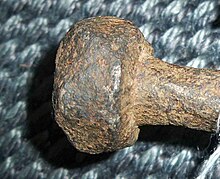Tekpi
Known as tekpi in Malay, it is called chabang or cabang (Dutch spelling: tjabang meaning "branch") in Indonesian,[3] siang tépi (雙短鞭 lit.
The tekpi is believed by some to have been derived from the ancient Indian trishula, a trident which can be either long or short-handled.
Other sources propose that it was brought to Southeast Asia from China,[4] but the tekpi in Sumatra and Malay Peninsula predates its earliest known use in China[1] and it seems unlikely for the Chinese to introduce an Indian weapon to a region already heavily influenced by the culture of India.
Use of the tekpi probably spread with the influence of Indian religion and eventually reached Malaysia, China, Thailand, and other parts of Indochina.
It is utilized just like its shape would suggest, as it is a weapon used for fast stabs and strikes similar to a knife or a kris.


